The past week has been characterised by an oxymoron: frustrating awesomeness (I know, “awesomeness” isn’t a word, but it gets the point across).
First, the frustration. We started the week with a brief, but powerful windstorm at around 04:00 on Sunday night that literally blew stuff off our balconies and dislodged coconuts from their high perches. The maelstrom sounded like a typhoon, and I was concerned that we wouldn’t be able to go out.
By daylight though, things looked much better...relatively flat seas with little wind. Much relieved, we headed out in the morning, and even managed to find a mom/ calf pair (#29 of the season). But within minutes, the skies turned to grey, while the winds shifted direction and picked up to 20+ knots. Four+ metres swells kicked in just for our added pleasure.
Aiyah.
The next day, we found a demonic mother/ calf pair (Unknown #17) early in the morning. The pair popped up for a quick breath, dived down, swam for 100-150m in a random direction, then repeated this cycle. They led us on a wild-whale-chase, until we gave up and moved on, unable to establish an ID. A couple of other boats also wasted invested time in this pair, but no one managed to get a good look.
After that, we found a singer. Just as I got everyone into the water, it stopped singing and left. How rude.
Then, we found another mother/ calf pair at the bottom end of Hunga channel, which was only marginally more cooperative than the demonic duo. I managed to get a reasonably good look, but no one else did, as the pair moved too quickly. It turned out to be whales I knew already but haven’t assigned an official ID to yet, Unknown calf #10 and mom.
And finally...Thursday was just a wipe-out day. Total, utter nothingness...unless you happen to be fond of clouds, rain and bad visibility.
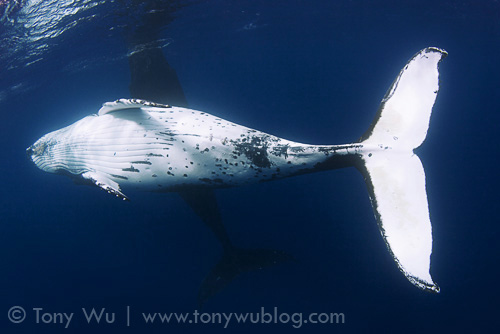
Courting humpback whales: the white one in front is the male,
the whale spyhopping in the background is the female.
But (and this is a big but), these periods of despair were more than offset by some amazing encounters, including:
(a) The best calf interaction I’ve had the entire season, with a baby humpback that turned out to be #32, Toluua. This ID broke our record of 31 pairs ID-ed in 2009, and...to make this encounter even more rewarding and poetic, the mother was the same female as the mom of calf #13 in 2009, Luna. I recognised the adult on sight, and of greater significance, I knew her “personality” (more about this below);
(b) A power-packed, testosterone-laden 8-whale heat run (woohoo!);
(c) Two pairs of courting male/ female humpback whales (power, grace and beauty);
(d) Re-sightings of several mother/ calf pairs previously ID-ed this season;
(e) A bunch of other stuff: two hammerhead sharks at the surface (one small, one large), two sea snakes (one of which had a little fish swimming with it, the other of which had Dan swimming after it...Dan’s comment “Snakes feel good; wet snakes feel better.”); a female crab swimming in mid-water carrying a large clutch of nearly ripe eggs that we initially mistook for a turtle; one actual sea turtle that had the good sense to dive before we got into the water; birds dive-bombing and snagging flying fish; pilot whales (one of my boats with Japanese friends on it); and a lot of breaching and other humpback whale surface activity.
It’s a New Record!
We actually ended this week with 34 humpback whale mother/ calf pairs ID-ed, but the one that really mattered for me was Toluua (#32) a little female calf (actually, she was quite big, indicating that she was born relatively early in the season).
Back in August (see Part 2), I set a goal of identifying at least 32 mother/ calf pairs this season. I had set out a case for a possible banner baby boom this season at the end of the 2010 season, and I saw evidence early on that the pace of calf sightings was consistent with a record-breaking tempo.
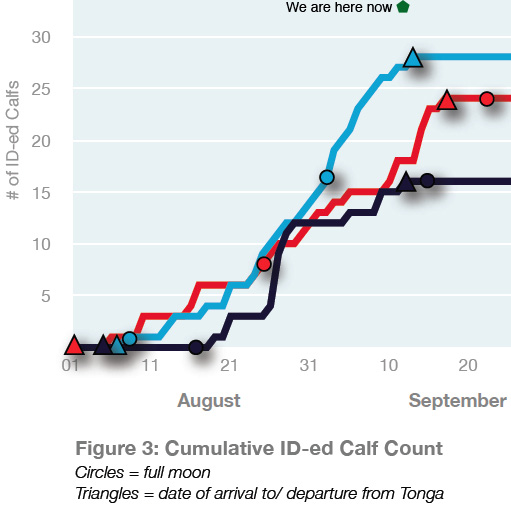
We've broken the humpback whale calf count record!
(black = 2008; blue = 2009; red = 2010)
Extracted from my 2010 humpback calf summary.
On Friday, 9 September, I was able to identify #32! (subject, of course, to going through all the photos and data more carefully after I get back home).
Reaching this benchmark was satisfying enough, but the actual encounter made the moment even more fulfilling.
First, I recognised the mother on sight. She was the mother of Luna, calf #13 in 2009, and is easily identifiable by her unique dorsal fin...sort of a stubby shape with white rune-like markings on it. I recall meeting this female for the first time in 2009, when I remarked: “If I ever see this one again, I’ll know it right away”, and sure enough, when I saw her dorsal fin on Friday, there was no mistake.
Even better...I remembered that she was very approachable. During several encounters two years ago, this female never swam away, never veered, never gave any indication she was troubled by the presence of boat or people.
With this in mind, I swam right to her when I got into the water, and sure enough, she swam directly toward me without hesitation. That left no doubt in my mind that it was the same whale.
I’m sure many biologists would frown upon ascribing a specific “personality” to a non-human animal, but in the two cases where I’ve immediately recognised an adult female humpback whale in different seasons, their dispositions have been the same (beside the mother of Luna/ 200913 and Toluua/ 201132, also the mother of Scratches/ 200801 and Stitches/ 200904).
To put it more bluntly, I was reasonably confident that Toluua’s mom would be comfortable with me right away, because she was comfortable in each encounter two seasons ago. Really comfortable.
Even more interesting, both of her babies, Luna and Toluua (both little girls), were also friendly to people, each demonstrating keen interest in swimmers, and approaching proactively.
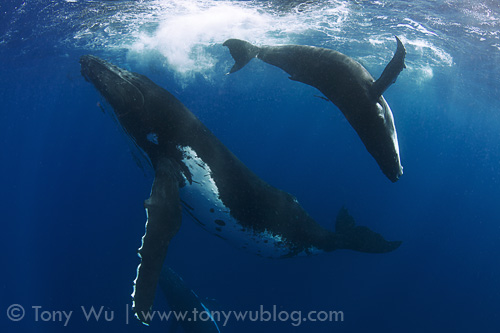
Humpback whale calf Toluua playing, with mom and escort below
Here’s the thing...for most visitors to Tonga, who may, if they’re lucky, only meet a few mother/ calf pairs while they’re here, it’s impossible to notice possible traits like consistent personality of a single whale.
Say someone travels here for a couple of weeks and comes across 10 mother/ calf pairs. Two seem friendly, five seem neutral and three speed away at the mere suggestion of humans.
It’s easy in such a scenario to make observations such as: “That boat harassed those whales, and that’s why they sped away.”, or “We knew exactly what we were doing, and that’s why we were more successful than you.”, etc.
I’ve heard definitive statements of this nature asserted by tourists, boat operators, NGO representatives, and researchers many, many times over the years, and I’m certainly not immune from having similar sentiments at times.
But...what I’ve come to believe after spending so much time in the water with these animals here, perhaps more than any other person ever has, is that individual whales have unique dispositions/ temperaments (with the caveat that immediate circumstances, such as the presence of an unwanted escort, can of course affect behaviour).
So Luna’s/ Toluua’s mom behaved in the same manner in 2009 and 2011, just as Stitches’/ Scratches’ mom behaved in the same manner in 2008 and 2009.
And while we humans most probably can and do affect the whales’ behaviour, individual whale “personality” is an important factor, one that cannot be dismissed as nonexistent, irrelevant, or imaginary.
Bottom line...just because people haven’t spent enough time getting to know humpback whales in their element doesn’t mean we are justified in ignoring their unique personalities, or in drawing conclusions/ making definitive statements/ creating policy based primarily upon human standards, prejudices and most of all...ignorance.
It’s difficult for me to prove beyond doubt that this observation would hold true for the population at large, but after having spent hundreds of hours observing humpback whales in the water here, it’s a view that I am confident about articulating and defending, especially now that I have two indisputable, multi-year examples.
Anyway, Toluua and mom played with us for a long time, with mom stopping on occasion to rest while Toluua frolicked with us less-talented swimmers. At one point, an escort joined the pair (making huge gulping motions down deep as he approached), but fortunately, the escort seemed as comfortable with us as mother and calf were.
What a wonderful way to reach my goal for this season.
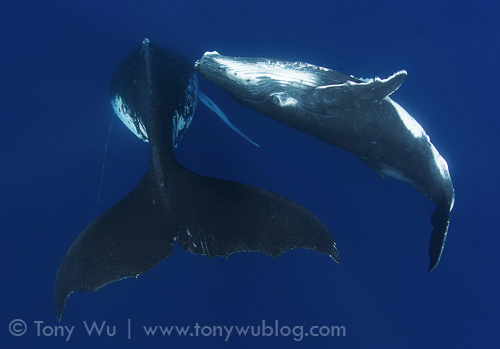
Toluua (calf #32). Toluua's mom is also the mother of Luna, calf #13 from 2009.
More Baby Talk
It’s terrific seeing so many baby whales. It’s vindication in many respects, but most of all, for the many “discussions” we had years ago with people here who felt there were only a handful of juveniles born/ raised around Vava’u each season.
Establishing a methodical, documented calf count has provided an objective measure, and has shown that our initial gut feel that there were dozens of babies in many seasons seems to be correct.
There is certainly more that we don’t know about these whales than we do, but every little bit of fact-based information helps.
Besides our new calf IDs this week, we also had several re-sightings:
(a) Second sighting of Unknown #10, originally spotted on 1 September, this sighting on 6 September, an interval of 5 days. I have some photos of this underwater, as well as topside images of the mom’s and calf’s dorsal. The underwater images aren’t great, so I’m not prepared to assign this one an ID yet, but at the end of the season, if nothing else matches, this is a strong candidate for an additional ID;
(b) Sixth sighting of Tahafa #14 (the injured calf), meaning this calf has been here for at least 17 days, spanning 23 August to 9 September. Of interest, mom and baby have been accompanied by the same escort since at least 1 September. I don’t recall documenting such a long female/ escort relationship before. Good news...the injured calf looks healthy, strong and playful...hurray!
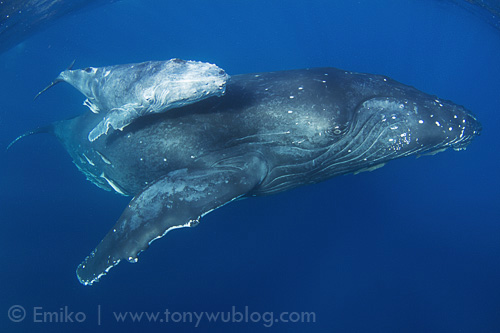
Sixth sighting of injured calf Tahafa (calf #14)
(c) Second sighting of Tolunoa #30. This mother/ calf were first photographed on 4 August by a guest at Mounu (before I arrived in Tonga). I have copies of some of the photos taken at that time. We photographed the same mother/ calf pair on 5 September, an interval of 32 days. The calf is a female.
(d) Fourth sighting of Tolu #3, a little boy. We initially ID-ed this mother/ calf pair on 18 August. This sighting was on 9 September...an interval of 22 days. Of note, there was no escort with mom and baby this time. I discussed the effect of an escort upon Tolu’s mom in Part 2, under the “Sex Change” sub-section.
It’s great having so many calf IDs and re-sightings this year...but wow, it’s so much(!!!) work cataloguing all the information and keeping it straight.
More Awesomeness: Heat Run
It’s been a while since I’ve seen a heat run this season. The fact that it’s been quite windy for a while may have something to do with this, as the humpbacks have a tendency to take their heat runs somewhat offshore where we can’t go if the conditions are too rough.
On Friday (same day that we ID-ed Toluua #32), we came across a massive 8-whale heat run. That’s over 300 tonnes of animal charging through the water at high speed, snorting, grunting and splashing the entire time!
The whales were travelling at high speed and diving a lot, so we only managed a few looks in the water. I almost got all eight whales into one frame:
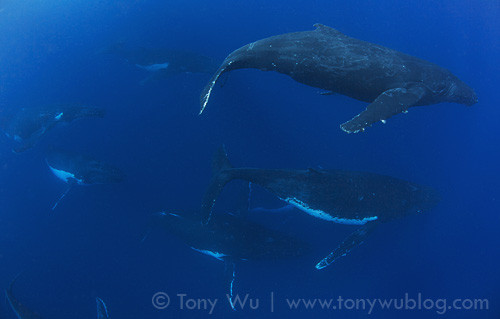
Heat run with eight whales. Travelling fast and diving deep.
I’m a heat-run addict, so every single heat run I see is as exciting as my first. Maybe I’m affected by the excess of humpback hormones in the water?!
Yet More Awesomeness: Couples Week
One of the most beautiful and awe-inspiring sights on the planet is the courtship of two humpback whales.
Over the years, I’ve been fortunate enough to witness the interaction of perhaps ten such pairs or so, and all I can say is that the whales’ combined grace, power and elegance defies description. Imagine the most intricate and refined of ballets, choreographed and performed by 40-tonne animals in the water, with every move executed to pinpoint precision.
On Tuesday (after our frustrations with the demonic duo mother/ calf, the non-singer singer, and Unknown calf #10), we came across a courting pair, just as we were about to throw in the towel and call it a day.
At a distance, we saw five whales together, so it’s quite possible that there were other whales with the pair before we reached them. But by the time we arrived on the scene, only the two were left, and from the moment we went into the water, they were as friendly and inquisitive as can be.
When the circumstances are right, courting pairs can often take an extraordinary interest in people, and even go so far as to “incorporate” swimmers into their elegant love-inspired rituals. I’ve swum on numerous occasions among the sinuous motions of two lovestruck whales, and have, after much experience, grown accustomed to their proactive swim-bys...when the whales turn around and head straight for me...an intimidating sight, but behaviour that I now know is not aggressive, but is intended to encourage me to keep up with them, even as I pant and heave for every breath.
We were in open water, far outside the main Hunga area, so the whales could have easily ditched us. Instead, they circled around and around, coming back every time we couldn’t keep up...behaviour typical of a friendly courting pair.
We swam non-stop for nearly an hour, so everyone spent lots of quality time with the amorous whales. It’s really amazing how long, hard and far people can swim when they’re making eye contact with humpbacks!
I consider myself fortunate if I come across one amicable courting pair a season, but on Saturday, we saw another, at Toku.
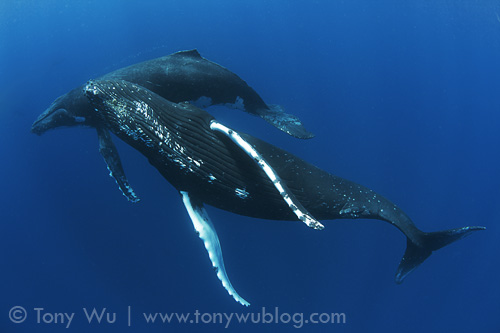
Courting pair (dark one female, white belly male) that was buzzed constantly
by two or three single males at Toku Island.
Toku Reloaded
Sean, Ray, Dan, Kozy and Nana started their adventure here with a trip to Toku, and we ended with a visit to Toku as well, on the final day of their stay in Vava’u.
Travelling the 40km or so to this small island requires relatively benign wind and ocean conditions, so it’s not an excursion that can be undertaken often. In fact, I had only visited once prior to this season. For one group to manage two visits to Toku in one trip is quite a stroke of luck!
Even better, it rained all day in Vava’u, while we had brilliant sunshine while we were at Toku.
It seemed like there were fewer whales overall around Toku this time, but we came upon a courting pair right away.
As is often the case with such pairs, the female demonstrated significant interest in us. The encounter wasn’t as rewarding as the previous pair, however, as two males (three at times), continually pursued this two lovebirds (lovewhales?), perhaps challenging the male.
As a result, the couple couldn’t focus on their courtship rituals and swam continually. The water was full of high-pitched squeaks, squeals and other calls, perhaps banter from the would-be challengers taunting the male in the pair. (Note: Humpback whales can be very talkative. Their well-known songs are just a small part of their vocal repertoire.)
We did manage to see the pair and the challengers up-close a few times though.
Toward the end of our final day at Toku, we came across a mother and calf (Tolutolu #33), accompanied first by two escorts, then three, then back to two, and finally one. While the female was swarmed by agitated males, she wasn’t terribly receptive to people in the water (go figure).
But when only one male was left, she relaxed, which allowed me to get a few photos for ID purposes.
Again, we witnessed first-hand the effect that escorts can have on female whale behaviour. It should perhaps come as no surprise that a mob of rowdy boys can make a respectable girl nervous, but it’s educational and rewarding nonetheless to see this up close.
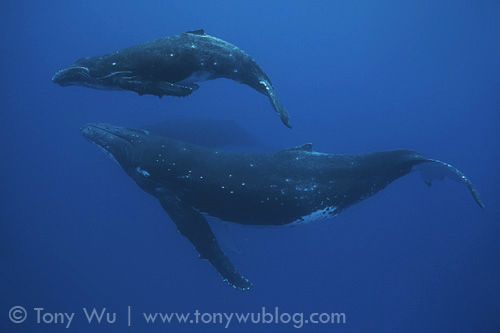
Tolutolu (calf #33 of the 2011 season) with mom